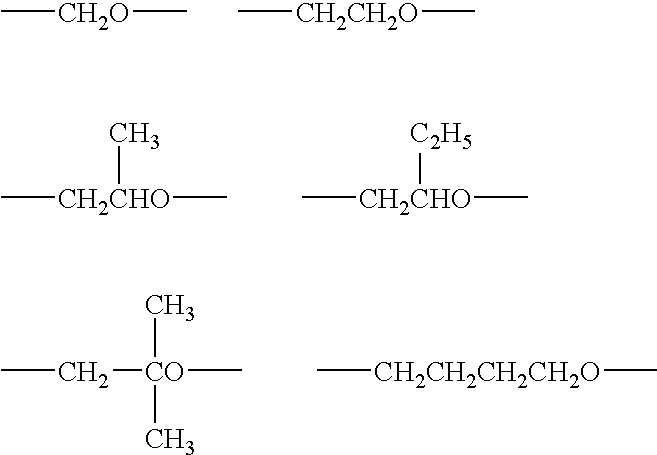Curing composition
a composition and composition technology, applied in the field of curing compositions, can solve the problems of lower curability and lower adhesion, and achieve the effect of satisfactory adhesion and practicable curability
- Summary
- Abstract
- Description
- Claims
- Application Information
AI Technical Summary
Benefits of technology
Problems solved by technology
Method used
Image
Examples
synthesis example 1
[0184] By use of a 1:1 (by weight) mixture composed of a polyoxypropylene diol having a molecular weight of about 2,000 and a polyoxypropylene triol having a molecular weight of about 3,000 as an initiator and zinc hexacyanocobaltate-glyme complex as a catalyst, polymerization of propylene oxide was carried out to yield a polypropylene oxide having a number average molecular weight of about 19,000 (a molecular weight relative to polystyrene standards measured by using a HLC-8120 GPC manufactured by Tosoh Corp. as a liquid delivery system, a column of TSK-GEL H-type manufactured by Tosoh Corp., and THF as a solvent). Then, a methanol solution of NaOMe was added in an amount of 1.2 equivalents in relation to the hydroxyl group of the above hydroxyl group-terminated polypropylene oxide, the methanol was distilled off, and allyl chloride was further added to thereby convert the terminal hydroxyl group into an allyl group. Thus, an allyl group-terminated polypropylene oxide having a numb...
experimental examples 1 to 15
[0186] In each of Experimental Examples 1 to 15, the reactive silicon group-containing polyoxyalkylene polymer (A-1) obtained in Synthesis Example 1 was used as the component (A); a filler, a plasticizer, a thixotropic agent, an ultraviolet absorber and a photostabilizer were weighed out respectively according to the prescriptions given in Table 1; and the all these ingredients were fully kneaded with a three-roll paint mill to yield the main part.
[0187] Then, in each of Experimental Examples 1 to 15, an organotin compound, the component (B), the component (C) and the component (D) were respectively weighed out as shown in Table 1, and these ingredients were mixed with the above described main part by stirring with a spatula for 3 minutes.
[0188] (Curability Test)
[0189] After mixing, the compositions thus obtained each were defoamed while being extended thinly with a spatula, filled in a molding frame of about 5 mm in thickness; the surface of each of the compositions was planariz...
experimental examples 6 and 11
[0192] Also when Neostann U-220, an organotin compound, was used as curing catalyst, no curability improvement effect was obtained even by addition of the component (C) (Experimental Examples 14 and 15).
PUM
| Property | Measurement | Unit |
|---|---|---|
| molecular weight distribution | aaaaa | aaaaa |
| molecular weight distribution | aaaaa | aaaaa |
| molecular weight distribution | aaaaa | aaaaa |
Abstract
Description
Claims
Application Information
 Login to View More
Login to View More - R&D
- Intellectual Property
- Life Sciences
- Materials
- Tech Scout
- Unparalleled Data Quality
- Higher Quality Content
- 60% Fewer Hallucinations
Browse by: Latest US Patents, China's latest patents, Technical Efficacy Thesaurus, Application Domain, Technology Topic, Popular Technical Reports.
© 2025 PatSnap. All rights reserved.Legal|Privacy policy|Modern Slavery Act Transparency Statement|Sitemap|About US| Contact US: help@patsnap.com



